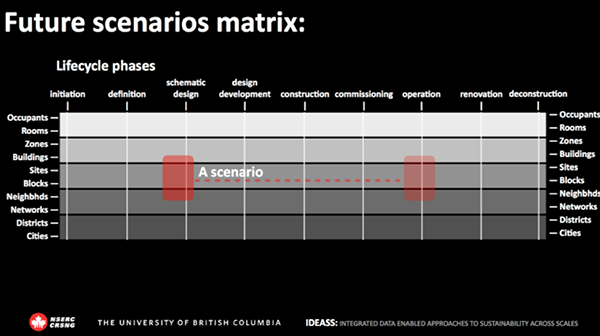
IDEASS has developed a matrix, pictured here, for defining the problem space of future scenarios of data integration in the lifecycle of the built environment.
The vertical axis articulates the scales at which the built environment is created (from the human scale of rooms at the top to the urban scale of cities at the bottom).
The horizontal axis represents a built environment lifecycle from planning and design to construction to decommissioning (from project initiation at the left to deconstruction at the right).
Within the matrix, users can define potential scenarios of data-enriched planning and design processes at points where data needed or created at different lifecyle phases and/or scales could be better connected or integrated to achieve better performance.
Applied: the matrix was used at the November 2012 workshop, where three scenarios were presented for discussion:
Scenario 1 – Building to site scales
How to accelerate generation, iteration and evaluation of alternative building systems?
Scenario 2 – Buildings across phases and scales
How to improve the interface between construction and operations?
Scenario 3 – Long-term neighbourhood planning
How to improve performance evidence and integration across scales?
Participants were invited to identify and situate their future scenario priorities on the same matrix. The use of the matrix within the project helped identify that these priorities tended to cluster at the scales of buildings and neighbourhoods, such that future scenarios effort would more effectively focus at these two scales.
Definitions
- A scenario illustrates a problem-driven research theme and associated agenda for the project.
- A scenario scope outlines the key drivers, issues and potential project partners in a scenario.
(A problem statement, diagnosis of current practice, a vision of a ‘better way’, critical decisions / decision-making processes to be improved, challenges and opportunities to achieving a ‘better way’, Stakeholders / interests, potential value, potential roles)
Each scenario scope might have a ‘data’ and an ‘engagement’ perspective.

